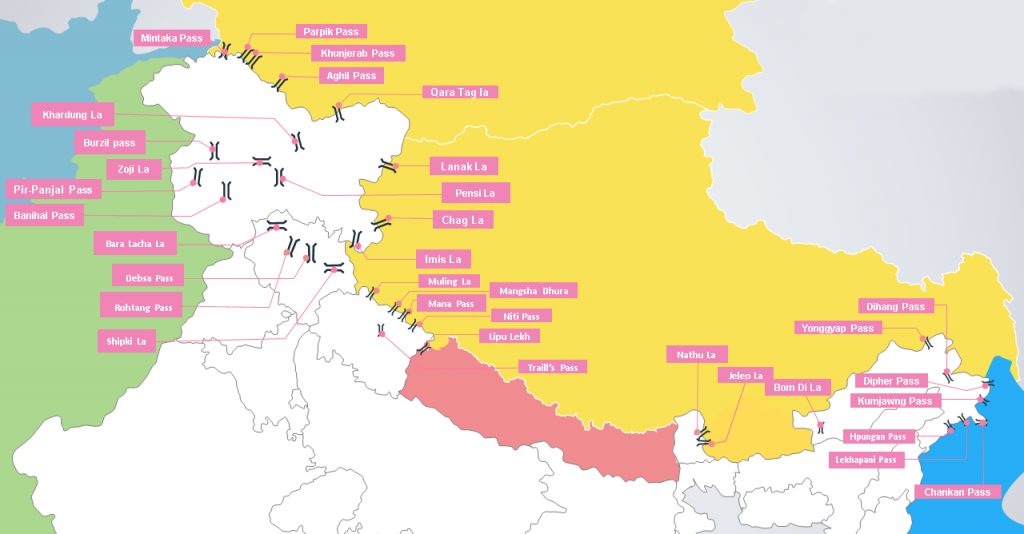Correct option is D
A. Jelep La: This pass is located in Sikkim. Jelep La is one of the major passes connecting India to Tibet through the Nathula range in Sikkim.
B. Shipki La: Shipki La connects Himachal Pradesh to Tibet and is located in the Kinnaur district of Himachal Pradesh.
C. Lipu Lekh: Lipu Lekh pass is located in Uttarakhand. It connects Uttarakhand to Tibet and is a significant trade route.
D. Banihal Pass: Banihal Pass is situated in Jammu and Kashmir. It is a crucial pass that connects the Kashmir Valley to the rest of the country.
Therefore, the correct matching is:
A → III (Jelep La → Sikkim)
B → I (Shipki La → Himachal Pradesh)
C → IV (Lipu Lekh → Uttarakhand)
D → II (Banihal Pass → Jammu and Kashmir)
Jelep La (Sikkim):
Location: Jelep La is a high-altitude pass situated at an elevation of approximately 4,290 meters (14,070 feet) in the Nathu La Range of the Himalayas, connecting India to Tibet. It is located in Sikkim, a northeastern state of India, which borders the Chinese Autonomous Region of Tibet.
Strategic Importance: Historically, Jelep La was a major trade route between India and Tibet. It connects the Indian state of Sikkim to Tibet and was crucial for the movement of goods and cultural exchanges between the two regions. In recent times, it remains significant for trade and political relations in the region.
Modern Relevance: It is less commonly used today for everyday transportation but continues to hold strategic significance in the context of Indo-Tibetan relations and regional connectivity.
Shipki La (Himachal Pradesh):
Location: Shipki La is situated in the Kinnaur district of Himachal Pradesh, another northern Indian state that borders Tibet. Shipki La stands as one of the primary entry points to India from Tibet, located at an elevation of about 3,200 meters (10,500 feet).
Historical Importance: Shipki La historically served as a passage for trade and pilgrimage between India and Tibet. It was an important route for merchants and pilgrims who traveled between India and Tibet, especially for those going to Lhasa.
Current Role: While trade has been limited in recent years, it remains a vital location in India’s geopolitical and economic relations with China. The pass also holds a certain degree of strategic military importance.
Lipu Lekh (Uttarakhand):
Location: Lipu Lekh is situated in the Uttarakhand state of northern India. It lies at a high altitude of approximately 5,335 meters (17,500 feet) in the Garhwal Himalayas and serves as a major trans-border pass. Lipu Lekh connects Uttarakhand to Tibet and serves as a natural link between India and China.
Strategic Significance: The pass plays an important role not only for trade but also for pilgrimage routes, particularly for the Kailash Mansarovar pilgrimage. It is an integral part of the Indian government’s efforts to maintain better infrastructure and connectivity in the region for strategic and defense purposes.
Historical Importance: This pass has been historically used by traders and pilgrims. In recent years, it has gained attention due to the potential for greater cross-border movement between India and Tibet, especially with the growing trade and diplomatic exchanges between the two regions.
Banihal Pass (Jammu and Kashmir):
Location: The Banihal Pass is situated in the Pir Panjal Range of the Himalayas in the Jammu and Kashmir region of India. It connects the Kashmir Valley to the Jammu region and serves as a crucial gateway to the valley from the rest of India.
Importance in Connectivity: Historically, the Banihal Pass has been a vital route for the Jammu and Kashmir region, providing access to the Kashmir Valley, which is often isolated due to harsh weather conditions in winter. The pass connects the valley to other parts of India, particularly for transportation, trade, and military movement.
Modern Relevance: The Banihal Tunnel, a part of the modern infrastructure, was constructed to overcome the challenges posed by the harsh winter conditions in the region. The pass continues to hold importance for the connectivity of the Kashmir region with the rest of India.







 English
English 50 Questions
50 Questions 60 Mins
60 Mins